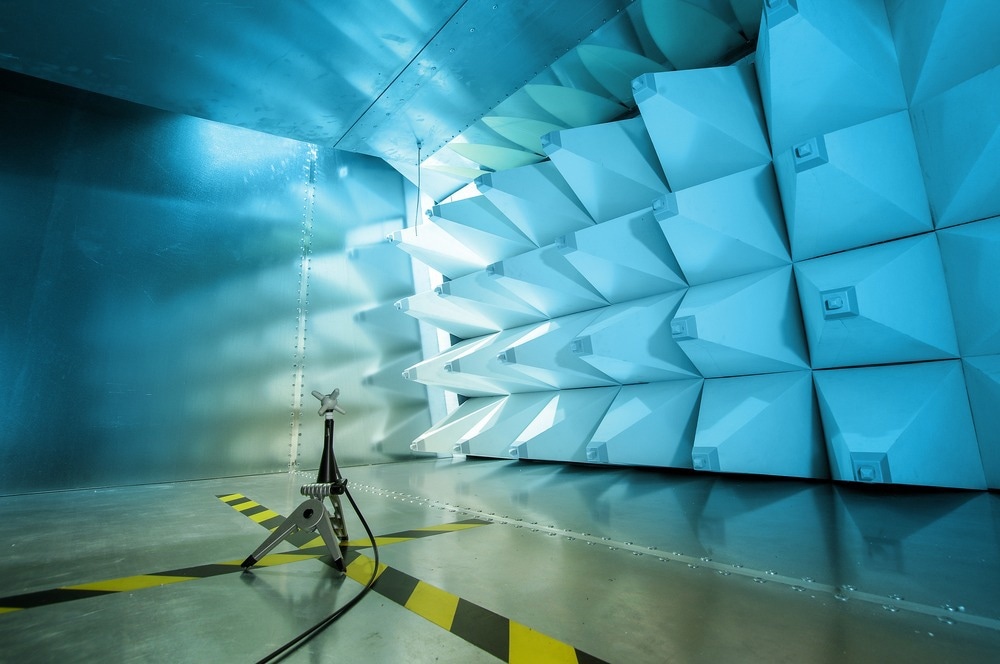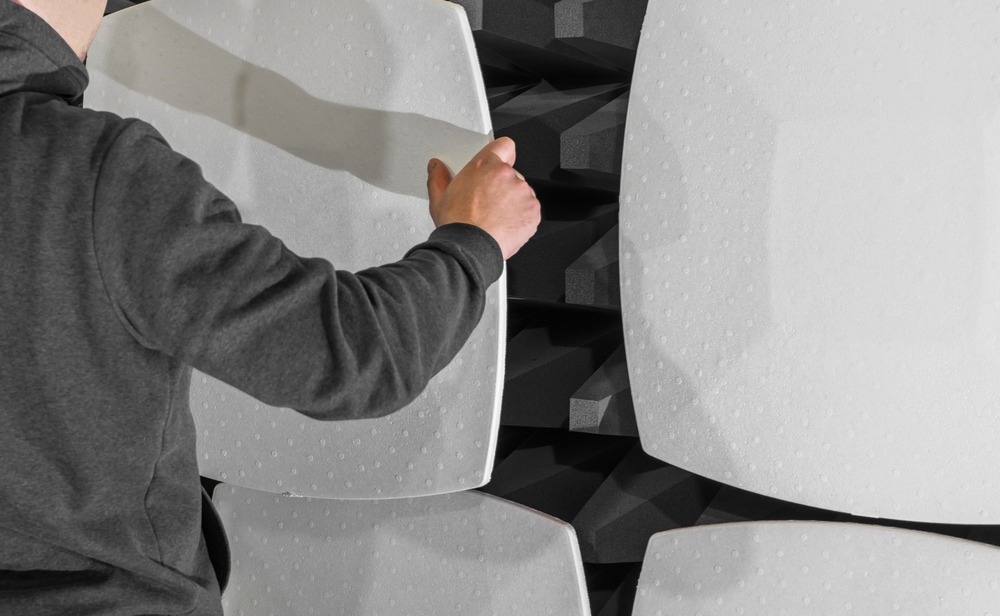Electromagnetic (EM) shielding creates a barrier that prevents interference from strong EM fields that could be harmful to sensitive electronic devices and live organisms. This review focuses on the development of high-performance EM shielding materials and methods for preventing EM interference.

Image Credit: Audrius Merfeldas/Shutterstock.com
In recent years, EM radiation has been regarded as an ever-growing safety concern for consumer electronics, biological systems, information technology, defense systems, and others. EM pollution caused by modern electronic and electrical equipment has been recognized as harmful to human health (causing headaches and sleeping disorders).
EM interference can also deteriorate the durability and correct operation of electronic equipment used in communication devices, consumer appliances, and automotive and aerospace electronic circuits. Therefore, EM interference and pollution have become a significant problem worldwide, and EM shielding materials and strategies play a crucial role in its mitigation.
How Does EM Interference Affect the Environment?
EM interference sources can be naturally occurring (lightning, auroras, cosmic radiation, and solar flares) or artificial (telecommunication networks, radio broadcasting, power transmission lines, measurement and control devices). The transmission of the interfering EM signal can occur via four different pathways.
In conductive EM interference, the stray EM fields travel through conductive mediums, such as grounding connections power or signal supply lines. The radiative EM interference propagates through the open space when the interference source emits an electromagnetic wave that is unintentionally transmitted to neighboring devices. In this case, conductors, such as cables and circuit board traces, can act as antennae that transmit and receive the interfering electromagnetic wave.
The capacitive EM interference occurs between conductors in close proximity (at distances comparable to the EM radiation wavelength). Such tiny separations create a parasitic capacitance, which becomes a pathway for transferring stray signals. Similarly, magnetic EM interference occurs at small distances, where oscillating EM fields can create stray currents across another conductor through electromagnetic induction.
Why EM Shielding is Necessary
The stray EM signals from the growing number of electric and electronic devices we use in our daily lives create considerable EM pollution. Such interfering signals can degrade the operation or even damage other neighboring devices or can cause harm to living organisms unless appropriate EM shielding is in place. EM shielding aims to isolate the EM emission of a device, minimize its effect on the environment, and, at the same time, block unwanted external interference.
The increased usage of electronics for data processing and communication, together with the interference generated by electrical transmission and distribution systems and natural phenomena, prompted international organizations, such as the International Special Committee on Radio Interference and the International Organization for Standardization, to develop EM compatibility standards to ensure that most of the electronic equipment operates correctly in an EM environment without generating or transmitting EM energy to other equipment.
Strategies for EM Shielding
EMI shielding is one of the methods, used alongside grounding and filtering, to achieve EM compatibility in devices. The method involves creating an appropriately shaped enclosure, made of suitable material, that can divert the propagation path of the undesired EM radiation coming into or out of the equipment.
The shielding enclosure can absorb and/or reflect the EM radiation using conductive or ferromagnetic materials. For example, a conductive material blocks the electric component of the EM field, while a material with high magnetic permeability blocks the magnetic component. In either case, this leads to attenuation of the EM field.
Reflection of the EM Interference
Reflection is the preferred EM shielding mechanism used in the industry. To achieve EM interference reflection, the material of the enclosure must be conductive (or contain mobile charge carriers), so that the incoming EM wave can interact with the mobile charge carriers in the conductive shield. This interaction creates an opposing EM field that cancels out the external field. In this case, highly conductive materials provide better shielding.
It is worth noting that an opening in the shielding enclosure larger than the wavelength of the external EM field will compromise its shielding properties. This is particularly relevant for high-frequency oscillating EM fields, where the shielding needs to be complemented with filtering devices to achieve good EM compatibility.
Absorption of the EM Interference
To absorb the external EM field, the enclosure material must exhibit a high dielectric constant and high magnetic permeability (or contain electric and magnetic dipoles). In the presence of an external EM field, such material diverts the magnetic field lines to pass through the material and not the shielded volume inside the enclosure. However, such materials are less efficient in reflecting EM radiation as they are less conductive.
The absorption of high-frequency oscillating EM fields occurs through eddy currents, which create an opposite magnetic field to the external one, thus canceling it out.
Materials for EM Shielding
Metals are the primary material for inexpensive and efficient EM shielding. Their properties such as electrical conductivity, magnetic permeability, mechanical strength, and ductility make them suitable for applications where structural shielding materials are required. Mild carbon steel and ferritic stainless steel, together with Fe-Ni alloys such as Mu-metal, Permalloy, and Supermalloy are commonly used for magnetic shielding.
Metal tapes and foils can be cut, shaped, and formed to fit any device with minimum added weight, making them an ideal EM shielding solution.

Image Credit: Trigub/Shutterstock.com
The development of intrinsically conducting polymers, such as polyaniline and polypyrrole, in the last couple of decades has offered a lightweight alternative to metals with much better processability. The conducting property of these polymers can be modified through doping or incorporation of metal nanoparticles or carbon nanotubes. Such shielding composite materials are widely used in aerospace applications.
Silicone rubbers and foams are flexible non-conductive materials that can be combined with conductive fillers (Ni or graphite) for EM shielding applications. Such materials are resistant to sunlight and water and can tolerate wide temperature ranges, which makes them an ideal shielding solution for extreme environments.
Nylon- or polyester-based textiles interwoven with thin metal wires offer effective shielding in various applications, such as EM shielding gaskets and seals.
Low-dimensional nanomaterials, such as carbon allotropes (exfoliated graphite, graphene, carbon fibers, and carbon nanotubes) and MXenes (transition metal carbides, nitrides, or carbonitrides) are commonly embedded in polymers, ceramics, and metals to create rigid or semiflexible materials that are particularly suited for high-frequency shielding application because of the small characteristic particle size of the nanomaterials.
Currently, the combination of conductive polymers and novel nanomaterials is one of the most attractive approaches for future EM shielding applications due to their low weight, corrosion resistance, facile processing, and commercial viability.
More from AZoM: How Does Laser Cleaning Technology Function?
References and Further Reading
(2018) Advanced Materials for Electromagnetic Shielding: Fundamentals, Properties, and Applications. Jaroszewski, M., Thomas, S., Rane, A. (Eds.), John Wiley & Sons 2018. Available at: https://doi.org/10.1002/9781119128625
Shukla, V. (2019) Review of electromagnetic interference shielding materials fabricated by iron ingredients. Nanoscale Adv.,1, 1640-1671. Available at: https://doi.org/10.1039/C9NA00108E
Iqbal, A., Sambyal, P., Koo, C. M., (2020) 2D MXenes for Electromagnetic Shielding: A Review. Adv. Funct. Mater. 30, 2000883. Available at: https://doi.org/10.1002/adfm.202000883
Wu, N., et al. (2021) Review on the electromagnetic interference shielding properties of carbon based materials and their novel composites: Recent progress, challenges and prospects. Carbon, 176, 88-105. Available at: https://doi.org/10.1016/j.carbon.2021.01.124
S. Melito (2021) What is EMI Shielding and Why is it Important for Your Design? [Online] Modus Advanced, Inc. Available at: https://www.modusadvanced.com/resources/blog/what-is-emi-shielding-and-why-is-it-important-for-your-design. (Accessed on 24 August 2022)
Yin, J., et al. (2022) A Review of Electromagnetic Shielding Fabric, Wave-Absorbing Fabric and Wave-Transparent Fabric. Polymers (Basel), 14(3), 377. Available at: https://doi.org/10.3390/polym14030377
Disclaimer: The views expressed here are those of the author expressed in their private capacity and do not necessarily represent the views of AZoM.com Limited T/A AZoNetwork the owner and operator of this website. This disclaimer forms part of the Terms and conditions of use of this website.